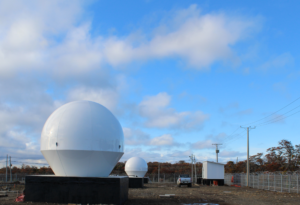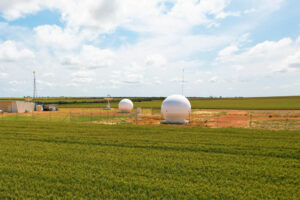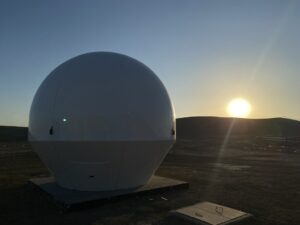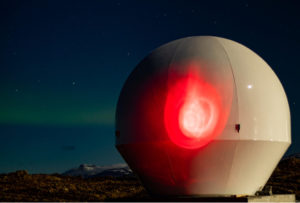JUNE 2020 – This position piece is produced in collaboration with commerical partner satsearch. Article originally published at satsearch.co – link.
Communication is key to the success of any space mission. Establishing and maintaining the right communication systems throughout the lifecycle of a satellite operation begins with Launch and Early Operations (LEOP).
LEOP allows engineers to check the health of the satellite as it enters orbit; stabilising it and running health and safety checks to be able to then commission the payload on-board. The routine operations of a satellite involve collecting its health status through telemetry and collecting the payload data (e.g. in case of a camera, the scenes previously captured and stored onboard of the satellite are downloaded). Teams can also fix bugs on-board the satellite and update software by uploading new code and patches.
Communications are established through ground stations that are installed in fixed locations on Earth. These ground stations may operate in different bands within the electromagnetic spectrum such as UHF/VHF, S-band, X-band, etc.
One of the key challenges for teams building satellites is to make a decision to either invest in building their own ground station or to subscribe to a service that allows them access to an established ground station network.
In the rest of this article we take a look at the key factors that need to be considered when weighing up whether to install your own ground station or subscribe to a ground station network.
Location
Ground stations work on line of sight which means that location is one of its most important features. The location of your ground station against the orbit of the satellite will ultimately determine how frequently you can contact that satellite and how long each of these contacts can be.
For example, if you have a ground station located in the North pole and have a polar low earth orbit (LEO) satellite at 600km, you will have up to 15 passes for communication and each contact may last up to 20 minutes.
Having a single ground station somewhere on the equator for a polar LEO satellite might limit your contact to only 3-4 passes maximum, with contact durations ranging from a few minutes to about 15 minutes.
As Taylor Silvio Dorigatti, Business Developer & Sales Engineer at Leaf Space, explains;
A peculiar issue to point out for the polar ground station example is that although you will have one pass per orbit, the polar region is highly congested with other satellites placed in polar or near-polar orbit.
These satellites’ orbits all intersect above the polar regions, and predictably generate an area of higher interference with respect to a ground station operating in mid-inclination or equatorial regions.
In addition, infrastructure placed in polar regions tends to have higher operational costs due to the limited real estate availability and harsh environmental conditions, compared to mid-latitude sites.
Your operations base may often be restricted to a certain city or town and establishing a ground station at your facility will have implications on the time and frequency of your contact. This is where a ground station network can help, as it will have stations present in multiple locations. A ground network often has ground stations located in multiple locations around the globe that will allow you to downlink and uplink to your space asset more frequently.
Real-time telemetry and telecommand
One of the most important drivers for ground stations is the mission requirement of how quickly the data from the satellite is needed by the end-user and how often you’ll want to be in touch with the satellite.
If the end-user of your satellite application is looking for near-real time information collected by the craft to be made available to them as soon as possible, you are most likely going to rely on multiple ground stations on Earth.
This is a situation in which you may benefit from access to a ground station network. Depending on the changing requirements of your end-users you may be able to negotiate flexible subscriptions to ensure the costs can be optimized while using a ground station network.
If your mission does not have such real-time operations constraints, you will have more flexibility in using your own station, either alone or in combination with some network capacity.
Compliance with local rules and regulations
Establishing a ground station also involves interfacing with local regulators in terms of getting clearance for a site to host the station and receive a license to effectively communicate with your satellite, often a time-consuming process for the ground segment. You have to be mindful of the rules that apply to uplinking to your satellite at a certain frequency and ensure that you do not cause interference with other terrestrial radio frequency sources.
Be sure to check the list of rules and compliances that govern the location where you intend to install your antenna. A site clearance process is common among many countries to make sure that satellite antennas being installed in a particular band, with a certain amount of output power, are not causing problems to other radio sources.
Using an established ground network service allows you to avoid these bureaucratic hassles altogether since it is the responsibility of the service provider to ensure ongoing compliance.
In addition, ground segment service providers typically have significant expertise in the regulatory process across different countries in order to get the satellite licensed; a capability that could be very helpful when starting a space mission, whether a single satellite or a constellation with global coverage.
The cost of installation and maintenance
Depending on the operating frequency, the size and type of antenna as well as supporting equipment (such as Low Noise Amplifiers (LNA), transceivers, etc.) will drive the cost of a ground station.
A Do It Yourself (DIY) ground station can be very easily built for a few thousand dollars if you plan to operate within the UHF/VHF band for all purposes of communication with your satellite.
However, going into higher frequency bands such as the S-band, X-band, etc., increases the size and the complexity of design choices in antennas and other equipment.
Typical design choices might include whether you will use a wire mesh against a dish for the antenna or choose between traditional modems and Software Defined Radio (SDR) based solutions.
One also has to keep in mind other issues such as hazards due to weather, ensuring the safety of the installation, and incorporating proper electrical power access as well.
Teams also have to be mindful of the maintenance aspects since ground stations rely on a number of mechanical elements, such as rotators, which may need regular servicing.
Therefore, you will have to take into account the overall cost of installing and maintaining a ground station against the duration of the mission itself. Often, it is quite time-consuming to set up agreements with teleports providing hosting and maintenance services for your ground station, something that a ground segment service provider instead takes care of independently.
Reliability figures should also be taken into account when designing or purchasing a ground station system and setting up hosting agreements. Typically, as much as you spend for hardware the more you’ll spend on maintenance to keep your reliability figures in your operational range. Since the ground segment is a key component of your mission success chain, its reliability has a huge impact on the mission.
As an example, if your mission is only for 6 months using the S-band for payload operations, the cost of developing your own station and operating it may be much higher than choosing a ground station network subscription. As Taylor explains;
This is usually the case for the majority of small satellite missions when you extensively analyze the numbers of the ground segment part of your project.
Technical compatibility
Communication systems come in pairs; they have to match in order to be able to communicate without problems.
Satellites carry radios that communicate with the ground and ground stations feature complementary radios to communicate with satellites. Often there is a setup cost to ensuring that the radios that the satellites are carrying are compatible with the ground equipment.
If you use different radios for each of your satellites you need to ensure that the ground station is compatible as well.
The Consultative Committee for Space Data Systems (CCSDS) was created in 1982 for governmental and quasi-governmental space agencies to discuss and develop standards for space data and information systems for this very reason. Sticking to globally accepted standards will also ensure very easy cross support and space link services from other ground stations.
Ground station networks often come with a list of readily compatible radios for satellites. This ensures that the setup time for ensuring technical compatibility is shorter and the integration simpler to manage. As Taylor states:
Moreover, a ground segment as-a-service provider, such as Leaf Space, may use Software Defined Radios (SDRs) in its ground stations. These systems are capable of becoming compatible with the transceiver used by your satellite thanks to deployable software patches developed or already available to the provider.
In addition, this can help you be flexible with your supply chain in terms of selecting vendors for the radios for the satellite each time.
Mission operations software for scheduling operations
There are a host of free software programs available online if you are looking to fly a satellite. They allow you to very easily interface your ground station to a computer in order to be able to control the ground station and manage the communication with the satellite without having to write your own code.
However, they may not come with support for simple scheduling of multiple satellites and missions, as Taylor explains:
The automatic scheduling functionality is available with Leaf Space’s service provision. We take care of scheduling in an optimized way satellite passes over the distributed ground station network, based on your specific requirements.
Innovations by ground station network providers today allow the use of rest-APIst to interact with multiple ground stations and allow automating much of the operations in a far simpler manner. As Taylor describes;
Leaf Space provides a versatile and easy to use API interface to customers for the ground segment operations management of their mission, while real-time uplink and downlink communication is controlled by the customer through a dedicated interface using a message queuing protocol. In addition, Leaf Line is already compatible with main Mission Control Software Providers, making even painless and faster to start operate your mission.
In conclusion
There are many factors that need to be carefully balanced before you make a choice between setting up your own ground station or choosing a ground station network provider.
You need to be mindful of the various issues discussed above, such as the number of satellites, requirements of your end-user for near real-time access of information, autonomy and assistance in scheduling operations of your satellites, compliance with your local regulations, and ensuring fit with different radios and communications standards.
Ultimately all of these drive the total cost of ownership and convenience of either setting up your own ground station or subscribing to a ground station network service that can provide you with a high quality and reliable service, also satisfying required SLAs.
We hope that this article has made that decision a little clearer for you!








